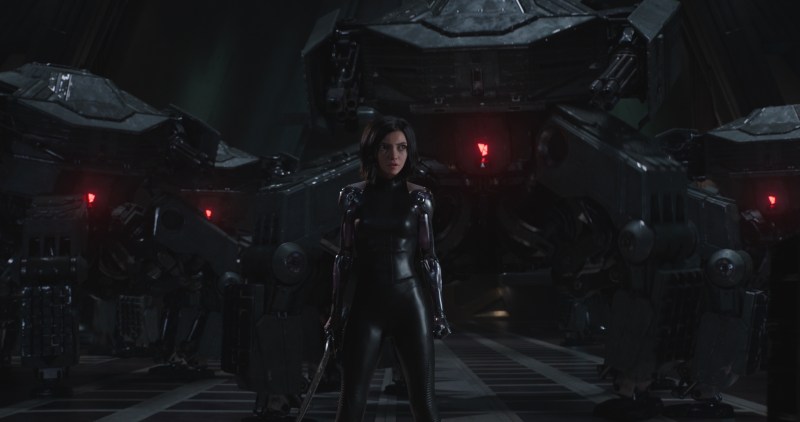Robert Rodriguez was never meant to have this much money. This is a man who thrives on shlock, from his 7000 dollar action masterpiece “El Mariachi,” to the horribly animated thumb-people in “Spy Kids,” to the guns attached to breasts (“Machete Kills”) and penises (“From Dusk ‘Till Dawn”) that mow down hordes of angry vampires/zombies/goons. Yet, here’s James Cameron, master of the blockbuster, handing 200 million dollars, a state-of-the-art motion capture rig, and an army of artists and set builders to a man who could make a movie out of a toothpick and some pocket lint.
But in exchange for this Powerball-budget, Cameron glues his hands to what should be Rodriguez’s steering wheel. There are two movies within “Alita: Battle Angel”: one, Rodriguez’s high-concept martial arts B-movie that couldn’t care less about being socially relevant or inspiring, the other, Cameron’s sappy, saccharine cliche-fest that should’ve sunk with “Titanic.”
It’s Cameron’s influence that drags “Alita” down from what it could be by misunderstanding what it should be. “Alita”’s script, which Cameron co-wrote, is full of misguided attempts to explore what it means to be human (mostly by saying, “am I human?”) and to create a “relatable” commentary on a girl’s journey to womanhood (which at one point literally involves Alita trading one body for another with larger metal breasts). Alita (Rosa Salazar) is a cyborg with no memory (an annoying, cheap trope that should’ve been left behind in the manga this film is based on), trying to get to a city in the sky despite a Bad Guy’s attempts to stop her. There’s a romance shoved in, which is cheesy enough at times to be endearing but which ultimately involves the two teenagers bonding over their shared ultra-edginess (which includes a lot of screaming “rahhh!” and then hitting something). It’s generic, forgettable, and useless.
“Alita: Battle Angel”’s first hour is full of heavy-handed dialogue that exposits the dull details of the film’s universe wiki-style while the audience cranes their necks to see the far superior visual “show-don’t-tell” world-building going on in the background. But when “Alita: Battle Angel”’s actors move out of the way the Iron City behind them is a stunning achievement of both CGI and practical effects, combining the aesthetics of “Blade Runner” and “Mad Max” into an immersive intricately-detailed painting that overwhelms the senses.
So we can be thankful when, in the film’s second half, those aesthetics are allowed to take over. Alita’s character suddenly drops her angst, as she transforms from young-adult-section refuse to bold (though somewhat generic) rogue ronin. The action scenes breathe with life, energy, and momentum, as colorful cyborgs throw their limbs at each other in a dance of metal and slow-mo. What Alita lacks in otherworldly gear (some of her enemies have knives or grappling hooks fused to their bodies) she makes up for in speed, zipping around the screen in an impressive display of athleticism as she conquers her bulkier foes with swift martial arts. The action is impressively brutal, robot organs and blue cyborg blood allowing for the type of satisfying dismemberment that would never otherwise be allowed in a PG-13 movie. One scene, in particular, stands out: a battle of epic scale that takes place within the futuristic blood-sport of Motorball, a combination of football, roller derby, basketball and NASCAR played by hulking half-robots on jet-fueled roller skates. Even if the other action scenes weren’t flamboyantly choreographed and weren’t shot with bone-crunching perfection (which they very much are), the Motorball chase alone is worth the price of admission.
It’s these action scenes that bear Rodriguez’s fingerprints all over them, and it’s these scenes that salvage the movie from mediocre joyless drama to what could perhaps be considered the first successful American adaptation of a Japanese manga. At the very least, “Alita: Battle Angel” knows what it’s good at, and scenes that in lesser blockbusters would have ended in minutes spiral ever-upwards into glorious absurdity, often prompting pumping fists and shouts of glee from the audience. Not since “The Last Jedi” have I seen viewers so immersed in the on-screen violence, cheering and leaping out of seats at particularly savage hits like Romans in the Colosseum.
Despite the system-glitch of a story and the expendable exposition, “Alita: Battle Angel” is ultimately a movie that is fun, mindless, and overwhelmingly cool. In the on-screen battle for creative control between Cameron and Rodriguez, it’s Rodriguez’s whimsy that ultimately claims victory. “Alita”’s story faded from my mind as quickly as its credits started rolling. But the image of a young wide-eyed half-human bashing in the head of junkyard cyborg with a leather ball, while the two fluidly fly across the screen atop futuristic roller skates, will never stop bringing a smile to my face.
Contact Noah Howard at noah.howard ‘at’ stanford.edu.
